Sorin F15 Eagle & F-15E Strike Eagle Page
| Name |
F15 Eagle |
| Contractor |
Boeing
|
| Purpose |
Universal
Fighter for the Air Force of the 3rd generation |
| Other |
it can carry 8t of payload, meant to replace the 2nd generation of F4 Phantoms, high resistance to ground fire, a high degree of digital equipment incorporated |
| Performance |
Mach 2 main air superiority highly meneouverable long range fighter |
| Maximum spd |
Mach 2.0 |
| Maximum alt |
15000 m |
| Cost/unit |
35 million dollars |
| Year |
1974 |
| Propulsion |
2x Pratt&Whitney F100 turbofans |
| Beneficiars |
US Air Force, US National Air Guard, Israel, Saudi Arabia, Iceland, South Korea |
Back to Sorin Fighters Network 5.0
Information about the Boeing F-15 Eagle
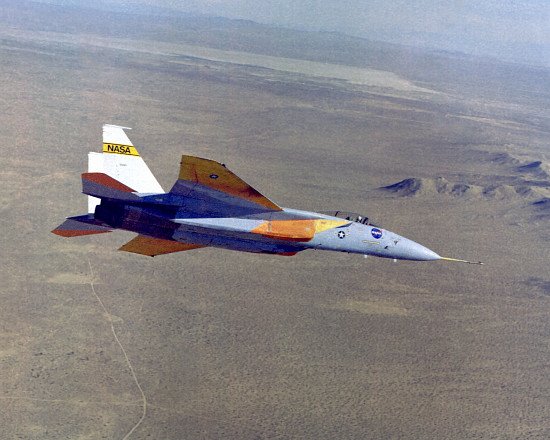 Name :
Name :
F-15 Eagle
Purpose :
Universal Fighter for Air Force
Maximum speed :
2400 km/h
Other Info :
+9G/-4G, the only US fighter accepted by both
US Air Force and US Navy
World's best air superiority fighter for over two decades
Models known :
F15A, F15B, F15C, F15D Eagle,
F-15E Strike Eagle |
In 1974, Boeing presented the brand-new F15 Eagle, who for about 6 years was
going to be the most powerful fighter in the air.
Before of that, Boeing tested the P-530 Cobra until 1966, when it transformed
into the F15 Eagle.
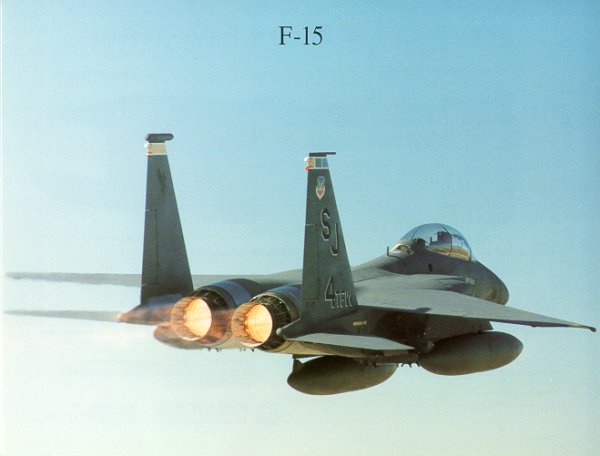
In the early 70s, the americans discovered that the russians were having
more advanced fighters than they thought before.
That's why the F14 Tomcat was no longer considered good for the USAF, and a
new fighter was developed.
Magnificient picture of a 4 F-15C Eagle formation, 1998
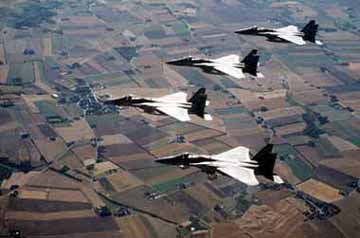
|
Magnificient picture of a 2 F-15C Eagle formation, 1998
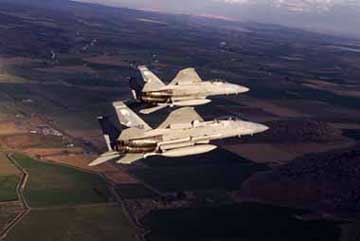
|
The F15 Eagle was smaller, more manoeuvrable, could carry more weapons and it could reach +9 G very easily. It also had a magnificent acceleration, it was much more advanced that the F14 Tomcat and it was good for both Navy and Air Force operations. F14 Tomcat was an interceptor for the Navy, and that's why the US Air Force desperately wanted a new fighter to fit their requirements.
|
F15 Eagle was exactly their dream. Until 1981 when it became obsolete, F-15
was the best official fighter in the air, slightly outmanoeuvred only by the Su27 Flanker and MiG29 Fulcrum, who appeared much later on the scene.
|
Another 4 F-15C Eagle formation, still in 1998
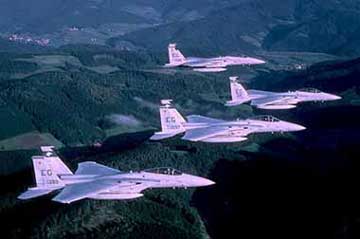
|
Oregon Mountains and the Oregon Eagle Squadron, still in 1998
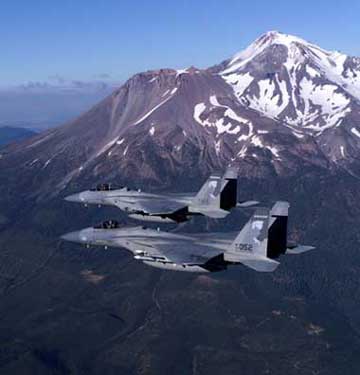
|
Well, those F-15s sure look so damn beautiful to me, and all those people who have always praised the beautyness of Russian fighters must've forgotten the beautyness of the good-old american ones.
Take a look at another formation, still in a Mountain region and an even better picture quality !:)
|
The 114th Fighter Squadron over Oregon
U.S. Air Force photo by Master Sgt. Dave Nolan
Two 114th Fighter Squadron, 173rd Fighter Wing F-15A Eagles from Kingsley Field ANGB, Oregon, fly a training mission over southern Oregon. The F-15 Eagle is an all-weather, extremely maneuverable, tactical fighter designed to gain and maintain air superiority in aerial combat. The Eagle's air superiority is achieved through a mixture of unprecedented maneuverability and acceleration, range, weapons and avionics. It can penetrate enemy defense and outperform and outfight any current or projected enemy aircraft. The F-15 has electronic systems and weaponry to detect, acquire, track and attack enemy aircraft while operating in friendly or enemy-controlled airspace. Its weapons and flight control systems are designed so one person can safely and effectively perform air-to-air combat.
|
F-15 Eagle Research aircraft
NASA uses a lot of fighters and former espionage aircraft in order to perform high speed, high altitude, manoeuvrability, digital systems, flight control systems, airodynamic and all sords of other tests for the benefit of World Aviation. Here are a few of the projects that use the F-15 Eagle as a test board
F-15 Eagle Highly Integrated Digital Electronic Control Research Aircraft
F-15B Eagle Airodynamical Research Aircraft
This is the F-15A Eagle Remote Flight Research/Spin Research Vehicle
The F-15 Eagle was a magnificient fighter as soon as it took-off from the first time. This F-15A Eagle was used by NASA for Remote Flights as well for testing Spins on highly manoeuvrable supersonic 9G fighters.

F-15 ACTIVE (Advanced Control Technology for Integrated Vehicles)
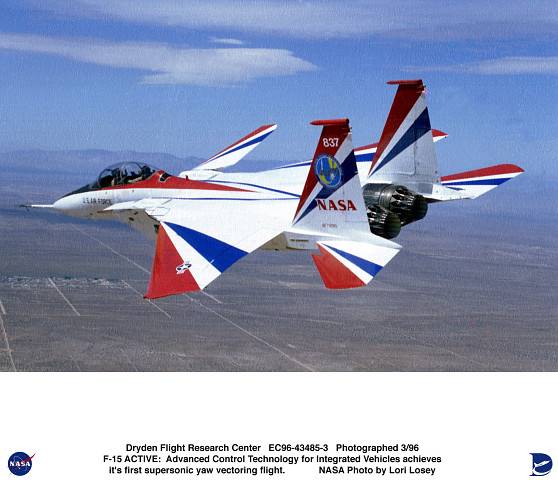
F-15 ACTIVE tests MATV on F-15 Eagles. The MATV used is an all-20 degrees indepent one and together with those weird huge cannards, appearently it works just perfectly. However, the US Air Force have definetly rejected any program for upgrading the F-15 and F-16s to a new standard, including Block 60 digital equipment, new radar, new propulsion, MATV, cannards and new weapons systems, saying that whatever upgrading will be done, the F-15/F-16 series will not be capable of maintaining a ferm superiority towards the new and increasing sophystication of foreign potentially hostile fighter programs, therefore all the attention was diverted towards the ATF Program. Well, I don't personally agree with that, as I do believe that a ferm and serious upgrading of the F-15/F-16 series could easily outmaneouvre, outgun, outperform and held a huge air superiority towards fighters like MiG-33, MiG-35, Su37, S-37, MiG 1.42, EF2000, Rafale or JAS-39, but I definetly agree with the diversion of all that funding towards the ATF. I mean, why upgrading oldies when you have a brilliant program already undergoing. Even my commie friend with who I've fought for many years now concearning military technology agrees that "I'd rather have 10 F-22s than 100 F-15s", and well, he's totally right.
The largest buyer for the F-15 Eagle is by far the US Air Force, followed by the Israeli Air Force and the US National Air Guard.
Some of the pictures in here also belong to the US Air Force
US Air Force
US Air Force
The F-15 Eagle is the backbone of two Air Forces, that's the US Air Force and the Israeli Air Force, and until the F-22 Raptor will arrive, which will take that role for both of these countries, the F-15 will remain the backbone of them both, as it is since the early 1970s
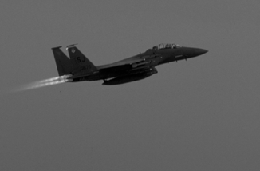 F-15 Eagle in Combat
F-15 Eagle in Combat
The F-15 Eagle seen live combat many times, the great majority of them taking part during the Gulf War of 1991, against Saddam Hussein's Iraqi Armed Forces.
F14 Tomcat and F-15 Eagle were the absolute heroes of that war, even tough both the Air Force as well as the Navy had already asked for their replacement more than one decade before. Other fighters took part to the operations with equal success, the F/A 18 Hornet and F-16 Fighting Falcon hiting Iraqi targets with deadly accuracy, but they were simply in less nombers than the F14 and F-15.
In one particular incident, during the very first hours of the war, one single Block 40 F-15C Eagle was flying an air supremacy mission just south of Baghdad when it encountered two Iraqi PC3 aircraft which were modified for Air Force use. The two Iraqi PC3s quickly started combat maneouvres, trying to get in the back of the Eagle and aim a russian missile at it. But the PC3 pilots waren't highly trained and their aircraft was of no match for the Eagle, so quite easily the F-15 turned and fired an AIM9L Sidewinder missile at the first PC3, which bursted into flame and crashed in the rocky desert landscape beneath. The second PC3's pilot got scared as his training was very slim and insufficient and his plane was not even a fighter, just a modified aircraft, so the F-15 pilot saw (the two aircraft were very close) the PC3's pilot looking at him, and when the F-15 turned its nose towards the PC3 in order to open fire, the PC3 pilot's face got incredibly scared and desperate, and he ejected right out of his airplane and watched it being destroyed by the Eagle in no-time. As the parrachute was descending from the very low altitude at which this fight took place (about 1,000 ft, that's 300m), the F-15 pilot saw his Iraqi counterpart smiling and waving his hand at him. Well, that was one quick victory.
In another incident, an F-15A Eagle squadron was rushing towards the Iraqi inlands and straight to Baghdad to shot down reported MiG29s and Ka choppers in the area, when they didn't noticed the AH64A Apaches moving stealthy towards the same coordinates just beneath them. Suddently seeing something on his radar, the back wingman of the first cell locked-on a Sidewinder missile on the Apache Leader. The Apache Leader later recalls freezing in his chair as he saw the red light of him being locked-on by an F-15. "I really thought that was it, when that F-15 locked on me. I thought he will fire and the both of us are going to die". Luckily, the F-15 got closer and saw it was an American Apache and he passed speedy above it. Boy, that must've been a release for the Apache leader :)
F-15E Strike Eagle
The F-15E Strike Eagle appeared in early 1990 after a project dating since 1989. The Strike Eagle is a two-seater F-15D which has dedicated air-to-ground capabilities, dive bombing facilities and a lot of integrated new technology built specifically for air-to-ground attack missions. The F-15E Strike Eagle is the last model of F-15 to be built and it entered service just about 6 months before the Gulf War had started. The F-15E had a very good mission profile and scored an 100% success in all its strikes during the Gulf War.
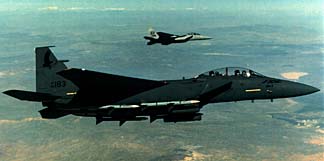 F-15E Strike Eagle in Combat
F-15E Strike Eagle in Combat
What strikes me at the F-15E Strike Eagle is that, for one thing, it has no G limitation software incorporated in the digital fly-by-wire flight control systems. An F-15E Strike Eagle pilot once told me that he took a 10G turn during a practice, and, of course, he never wants to go there again :), but I have always really believed that a fighter like the F-15E would incorporate such an instruction as standard.
The same F-15E Strike Eagle pilot stated that "You cannot move the stick in any direction and at any time like in the F-16", which makes the F-15E Strike Eagle a little bit harder to control and also with a longer response time to stick input, stuff that is very dangerous during a dogfight or a low-level attack mission for example.
However, the F-15E Strike Eagle is a remarcable fighter which has one and a half million lines of code in its digital fly-by-wire, flight controls and avionics integrated programmed systems. It's just a wonder why nobody ever thought of adding just one more line for limiting the maximum positive G to 9.0 or about 300 lines to build a software which would allow the pilot to select his own G restrictions before any mission...
The F-15 Eagle still remains the first and the only aircraft that shut down a satellite with a Pegasus missile, in 1985.
Block 50 F-15 Eagles were used in strikes against Iraq in 1994 while Block 40 versions of the same fighters have hit Baghdad two years before, in 1992. Also, following the 1996 attempt of Iraqi Intelligence to assasinate former US president George Bush, the USAF replied with a heavy series of air strikes, where the Block 50 F-15C/Ds were a very important piece of the attack force.
Also, Block 50 F-15C/D Eagles and F-15E Strike Eagles were used again in Operation Desert Fox, between December the 17th and the 20th, 1998, in Iraq.
The F-15's actions do not stop there, as it will be used again just a few months later, during March-April 1999, in strikes against Serbian Kosovo targets, Belgrade, Sarajevo, Strebrenica and a whole multitude of military and later on, civillian targets in the former Yugoslavia. The F-15C Eagles and F-15E Strike Eagles destroyed all the thermo-power plants, hydro-power plants, bridges, hangars, airfields and cereal deposites from all over Serbia and the provence of Kosovo, and later on bombed even an airfield which belonged to the Yugoslavian Air Club, destroying many gliders and towing aircraft, as well as a few towing trucks, tractors and a bunch of other materials used by the air club. The US Air Force did that under the suspicion that the Serbs were hiding Romanian-Yugoslavian built IAR J-22 Orao jet trainers and possibly even a few MiG21 Fishbeds. No comments about the success of the mission were ever released to the press, as the appearently 6 J-22 Orao fighters have not been hit by the bombings. They would be destroyed just a few days later during the war, when UAV spy planes would find them hiding in between the ruins of the former Yugoslavian Air Club hangars near Strebrenica.
During the Kosovo war, an F-15E Strike Eagle got separated from his squadron and fell into the awaiting trap of about 6 Yugoslavian MiG21 Fishbeds. The Yugoslavian MiG21s put on the afterburners and started to follow the F-15E in order to get on its back and shoot it down. Desperatly throwing its afterburners on as well, the F-15E Strike Eagle turned towards the Romanian border during the night of March the 17th, 1999 in a desperate attempt of entering Romanian theritorry (even tough that was still forbidden at the time to all forces involved in the conflict) in order to get rid of its chasers. The F-15E Strike Eagle penetrated the Romanian Air Space at around 04:07hrs in the morning of March the 17th and dropped two 600g (2270 l) fuel tanks near a Romanian village 5km away of the border with Yugoslavia. The F-15E was tracked all the time during its chase and run by the Romanian border radars at Craiova, by at least 3 or 4 mobile AAA radar units of russian productions, by the Romanian Radar Station in Arad and by the Romanian Air Force's extremly advanced american-built radar at Timisoara, which can track a target no less than 400km away under all weather conditions and which can also detect Stealth planes such as the F117 Nighthawk. Two or more Romanian Air Force MiG21 C Lancers also escorted the american fighter while on its first minutes in Romanian territory, then abandoned the escort in order to continue their border patrole mission. The American fighter turned back towards the common Romanian-Yugoslavian-Bulgarian border and re-entered Yugoslavian Air Space, landing safely aprox. two hours later at Aviano AFB in Italy. The next day, all kinds of Romanian officials, especially parliament personnel and government small-rank personnel took the day off from work and went at the border to obsearve the two fuel tanks dumped by the Strike Eagle in the previous night. The Romanian Armed Forces arrived immediatley to clean-up the place and take the empty fuel tanks away from the field, but they had to wait for more than 3 days to do that, as all kind of Romanian parliament members spent their "vacation" looking and wondering at the things. Well, I guess some people just landed from space or something... NO COMMENT ! ;)
Here is the US Air Force's Fact Sheet about the F-15 Eagle
Some of the data you'll read here might be slightly diffrent from what I've presented above, so I want my readers to have both facts in order to get a wider picture about the F-15. It also contains some interesting data about the weapons systems, deployments and combat actions. Enjoy.
USAF FACT SHEET 92-61
F-15 Eagle
Mission
The F-15 Eagle is an all-weather, extremely maneuverable, tactical fighter designed to gain and maintain air superiority in aerial combat.
Features
The Eagle's air superiority is achieved through a mixture of unprecedented maneuverability and acceleration, range, weapons and avionics. It can penetrate enemy defense and outperform and outfight any current or projected enemy aircraft. The F-15 has electronic systems and weaponry to detect, acquire, track and attack enemy aircraft while operating in friendly or enemy-controlled airspace. Its weapons and flight control systems are designed so one person can safely and effectively perform air-to-air combat.
The F-15's superior maneuverability and acceleration are achieved through high engine thrust-to-weight ratio and low wing loading. Low wing-loading (the ratio of aircraft weight to its wing area) is a vital factor in maneuverability and, combined with the high thrust-to-weight ratio, enables the aircraft to turn tightly without losing airspeed.
A multimission avionics system sets the F-15 apart from other fighter aircraft. It includes a head-up display, advanced radar, inertial navigation system, flight instruments, UHF communications, tactical navigation system and instrument landing system. It also has an internally mounted, tactical electronic-warfare system, "identification friend or foe" system, electronic countermeasures set and a central digital computer.
Through an on-going multistage improvement program the F-15 is receiving extensive upgrade involving the installation or modification of new and existing avionics equipment to enhance the tactical capabilities of the F-15.
The head-up display projects on the windscreen all essential flight information gathered by the integrated avionics system. This display, visible in any light condition, provides the pilot information necessary to track and destroy an enemy aircraft without having to look down at cockpit instruments.
The F-15's versatile pulse-Doppler radar system can look up at high-flying targets and down at low-flying targets without being confused by ground clutter. It can detect and track aircraft and small high-speed targets at distances beyond visual range down to close range, and at altitudes down to tree-top level. The radar feeds target information into the central computer for effective weapons delivery. For close-in dog fights, the radar automatically acquires enemy aircraft, and this information is projected on the head-up display.
An inertial navigation system enables the Eagle to navigate anywhere in the world. It gives aircraft position at all times as well as pitch, roll, heading, acceleration and speed information.
The F-15's electronic warfare system provides both threat warning and automatic countermeasures against selected threats. The "identification friend or foe" system informs the pilot if an aircraft seen visually or on radar is friendly. It also informs U.S. or allied ground stations and other suitably equipped aircraft that the F-15 is a friendly aircraft.
A variety of air-to-air weaponry can be carried by the F-15. An automated weapon system enables the pilot to perform aerial combat safely and effectively, using the head-up display and the avionics and weapons controls located on the engine throttles or control stick. When the pilot changes from one weapon system to another, visual guidance for the required weapon automatically appears on the head-up display.
The Eagle can be armed with combinations of four different air-to-air weapons: AIM-7F/M Sparrow missiles or AIM-120 Advanced Medium Range Air-to-Air Missiles on its lower fuselage corners, AIM-9L/M Sidewinder or AIM-120 missiles on two pylons under the wings, and an internal 20mm Gatling gun (with 940 rounds of ammunition) in the right wing root.
Low-drag, conformal fuel tanks were especially developed for the F-15C and D models. Conformal fuel tanks can be attached to the sides of the engine air intake trunks under each wing and are designed to the same load factors and airspeed limits as the basic aircraft. Each conformal fuel tank contains about 114 cubic feet of usable space. These tanks reduce the need for in-flight refueling on global missions and increase time in the combat area. All external stations for munitions remain available with the tanks in use. AIM-7F/M Sparrow and AIM-120 missiles, moreover, can be attached to the corners of the conformal fuel tanks.
Background
The first F-15A flight was made in July 1972, and the first flight of the two-seat F-15B (formerly TF-15A) trainer was made in July 1973. The first Eagle (F-15B) was delivered in November 1974 to the 58th Tactical Training Wing, Luke Air Force Base, Ariz., where pilot training was accomplished in both F-15A and B aircraft. In January 1976, the first Eagle destined for a combat squadron was delivered to the 1st Tactical Fighter Wing at Langley Air Force Base, Va.
Other units equipped with F-15s include the 36th Fighter Wing, Bitburg Air Base, Germany; 325th Fighter Wing at Tyndall Air Force Base, Fla.; 33d Fighter Wing, Eglin Air Force Base, Fla.; 32d Fighter Squadron, Soesterberg AB, Netherlands; and the 3d Fighter Wing, Elmendorf Air Force Base, Alaska. In January 1982, the 48th Fighter-Interceptor Squadron at Langley Air Force Base became the first Air Force air defense squadron to transition to the F-15.
The single-seat F-15C and two-seat F-15D models entered the Air Force inventory beginning in 1979. Kadena Air Base, Japan, received the first F-15C in September 1979. These new models have Production Eagle Package (PEP 2000) improvements, including 2,000 pounds (900 kilograms) of additional internal fuel, provision for carrying exterior conformal fuel tanks and increased maximum takeoff weight of up to 68,000 pounds (30,600 kilograms).
F-15C's, D's and E's were deployed to the Persian Gulf in 1991 in support of Operation Desert Storm where they proved their superior combat capability with a confirmed 26:0 kill ratio.
General Characteristics
Primary Function: Tactical fighter.
Contractor: McDonnell Douglas Corp.
Power Plant: Two Pratt & Whitney F100-PW-100 turbofan engines with afterburners.
Thrust: (C/D models) 25,000 pounds each engine ( 11,250 kilograms).
One M-61A1 20mm multibarrel gun mounted internally with 940 rounds of ammunition; four AIM-9L/M Sidewinder and four AIM-7F/M Sparrow missiles, or a combination of AIM-9L/M, AIM-7-F/M and AIM-120 missiles.
Crew: F-15A/C: one. F-15B/D: two.
Unit cost: $15 million.
Date Deployed: July 1972
Inventory: Active force, 403; ANG, 126; Reserve, 0.
Point of Contact
Air Combat Command; Public Affairs Office; 115 Thompson St., Ste 211; Langley Air Force Base, VA 23665-1987; DSN 574-5007 or (804) 764-5007.
October 1992
I can only end my small page for such a great fighter with a picture to match the power, superiority and spirit of the Eagle, showing two maintenance personnel wiping out the snow from the back of these 74th Air Wing F-15C Eagles in an Air Force base somewhere in the state of Arkansas during the harsh and cold winter of 1999.
The F-15 Eagle and its new version the F-15E Strike Eagle will always be a reminder of the US Air Force's Supremacy of the Skies
 F-15C Eagles being cleaned-up from snow in the state of Arkansas, 1999
F-15C Eagles being cleaned-up from snow in the state of Arkansas, 1999
Sorin F-15 Eagle Page is Copyright ©1998
by Sorin A Crasmarelu from Sorin®
updated 2001 by Sorin A Crasmarelu
Back to Fighters Network
All rights reserved
 Name :
Name : 




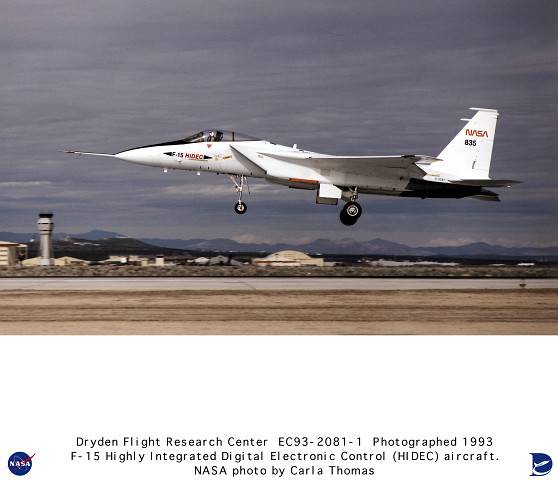
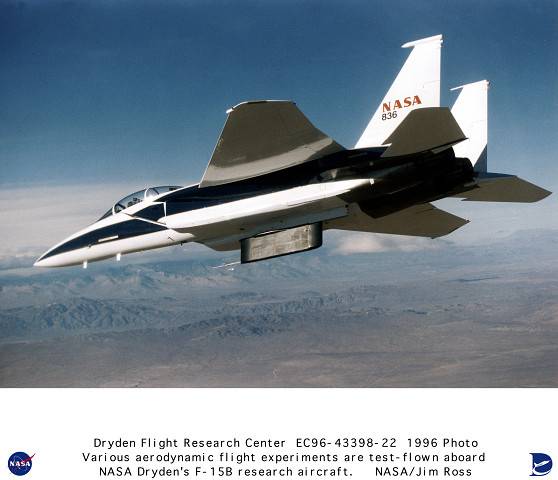



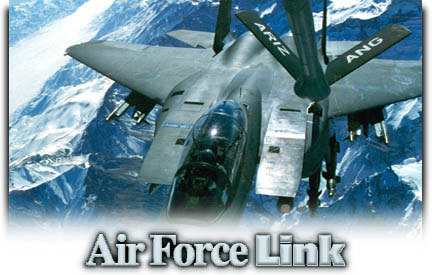

 F-15 Eagle in Combat
F-15 Eagle in Combat
 F-15E Strike Eagle in Combat
F-15E Strike Eagle in Combat
 F-15C Eagles being cleaned-up from snow in the state of Arkansas, 1999
F-15C Eagles being cleaned-up from snow in the state of Arkansas, 1999